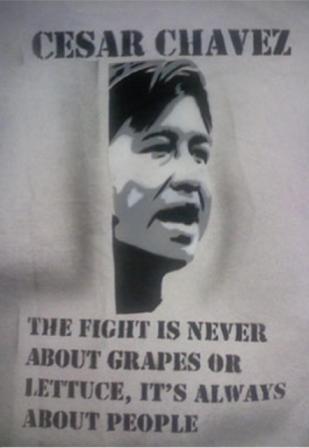Teaching Activity. By Andrew Reed. Rethinking Schools. 5 pages.
Teaching activity connects students to history of art as a means of protest and gives them opportunity and skills to create their own stencil with a powerful message.
Continue reading
Teaching Activity. By Moé Yonamine. Rethinking Schools. 18 pages.
Poetry, photography, and text are used in this role play to teach about the seldom told history of Japanese Latin American internment during WWII.
Continue reading
Teaching Activity. By Linda Christensen. Rethinking Schools. 10 pages.
Teacher reflection on different ways to effectively incorporate poetry into history or literature classes.
Continue reading
Teaching Activity. By Craig Gordon, Urban Dreams, and the Martin Luther King Jr. Papers Project. 2003, updated in 2017.
Lesson to introduce students to the speeches and work of Dr. King beyond "I have a dream."
Continue reading
Teaching Activity. By Moé Yonamine. Rethinking Schools. 11 pages.
Lesson based on ANPO: Art X War, a documentary about visual resistance to U.S. military bases in Japan by Japan’s foremost contemporary artists.
Continue reading
Teaching Activity. By Abby MacPhail. Rethinking Schools. 17 pages.
A lesson on the Keystone XL Pipeline battle.
Continue reading
Teaching Activity. By Bill Bigelow. Rethinking Schools. 15 pages.
Using chocolate chip cookie "mining," this lively activity takes a critical look at how the coal industry teaches the impact of coal mining.
Continue reading
Teaching Activity. By Bill Bigelow. Rethinking Schools. 13 pages.
Through encountering "clues," students probe the dangerous link between fossil fuels, carbon, and climate change.
Continue reading
Teaching Activity. By Linda Christensen. Rethinking Schools. 20 pages.
Teaching about racist patterns of murder, theft, displacement, and wealth inequality through the 1921 Tulsa Massacre.
Continue reading
Teaching Activity. By Bill Bigelow and Norm Diamond. 8 pages.
Lesson engages students in a lively simulation that helps them experience some of the pressures that lead workers to organize.
Continue reading
Teaching Activity. By Bill Bigelow and Norm Diamond. 3 pages.
This lesson introduces students to Bertolt Brecht’s poem, A Worker Reads History. Students reflect on the creative role of workers in making history.
Continue reading
Teaching Activity. By Bill Bigelow and Norm Diamond. 7 pages.
This lesson teaches some of the nuts and bolts of labor unions and then moves beyond to ask students to consider what rights they have at work, and to recognize that “rights” depend in large part on what people have fought for and won.
Continue reading
Teaching Activity. By Bill Bigelow and Norm Diamond. 4 pages.
In this simulation, students make paper airplanes to learn about the origins and effects of “scientific management”—owners’ attempt to capture workers’ skills and knowledge, and then to exploit that knowledge to reorganize work and cut costs by deskilling workers.
Continue reading
Teaching Activity. By Bill Bigelow and Norm Diamond. 6 pages.
Students work with a chapter from Milton Meltzer’s classic book, Bread and Roses, to see the impact of late 19th century factory work on workers’ home lives.
Continue reading
Teaching Activity. By Bill Bigelow and Norm Diamond.
This lesson uses Charlie Chaplin’s hilarious classic film, Modern Times, to help students think about the impact of “scientific management” on the workplace.
Continue reading
Teaching Activity. By Bill Bigelow and Norm Diamond. 8 pages.
In this playful activity, students utilize the principles of “scientific management” to restructure a burger joint—one that has been run a good deal more democratically and imaginatively.
Continue reading
Teaching Activity. By Bill Bigelow and Norm Diamond. 10 pages.
This role play activity on the famous 1892 Homestead Strike, explores the possibility of solidarity among workers of very different backgrounds and at different levels in the workplace hierarchy.
Continue reading
Teaching Activity. By Bill Bigelow and Norm Diamond. 7 pages.
Writing activity for students to complete the narrative of women workers striking at a glove-making factory, exploring possible outcomes.
Continue reading
Teaching Activity. By Bill Bigelow and Norm Diamond. 8 pages.
In this “mystery” activity, students receive clues and discuss some of the factors that contributed to the intensification of racism in the 1920s in the United States.
Continue reading
Teaching Activity. By Bill Bigelow and Norm Diamond. 20 pages.
Students “become” several of the social groups who participated in the 1934 Longshore Workers Strike — some of whom had to answer the question, “Which side are you on?”
Continue reading
Teaching Activity. By Bill Bigelow and Norm Diamond. 4 pages.
Activity for students to write from the point of view of one of the women featured in the film Union Maids.
Continue reading
Teaching Activity. By Bill Bigelow and Norm Diamond. 14 pages.
In this role play activity, students assume the roles of union members and attempt to figure out how to respond to a threatened plant closure.
Continue reading
Teaching Activity. By Bill Bigelow and Norm Diamond. 7 pages.
Students explore the power of songs to build solidarity and increase understanding. This is the final activity from Bigelow and Diamond’s labor history book, The Power in Our Hands, and draws on the other lessons.
Continue reading
Teaching Activity. Zinn Education Project. 21 pages.
Two lessons to introduce key facts about the Vietnam War and the Pentagon Papers, documents that provide essential history that is often ignored by textbooks.
Continue reading
Teaching Guide. By Bill Bigelow. 6 pages.
Lessons to accompany the 1985 video "Sun City" that promoted the cultural boycott of South Africa initiated by Little Steven van Zandt of Bruce Springsteen’s E St. Band.
Continue reading
























